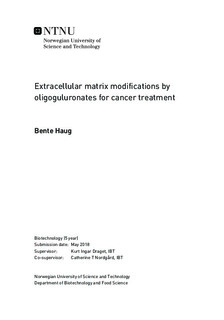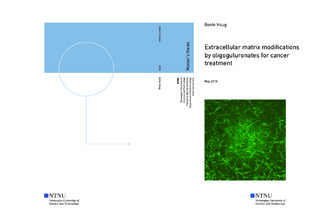| dc.description.abstract | Type I collagen is the main structural protein of the extracellular matrix, and is
abnormally produced in many types of solid tumours. The presence of a thick
and linearised collagen fibres constituting a dense network in a tumours microenvironment
has been linked to high malignancy and chemoresistance of cancers.
Rixova is a novel drug-candidate based on G-blocks that has demonstrated promising
results in normalising the extracellular matrix, reducing tumour growth and
enhancing drug delivery in preliminary clinical studies. This thesis investigates the
modifications of collagen network structure and viscoelastic properties by treatment
with G-blocks, which are highly defined and short, bioactive guluronate
oligomers derived from alginate.
The effect of G-blocks on the fibrillation of type I tropocollagen monomers was
investigated by simultaneous timelapse confocal reflectance microscopy visualising
the structure of the collagen network, and by multiple-particle tracking with meansquare
displacement- analysis measuring the microrheology of the solution. This
new method of monitoring the sol-gel transition combines two established techniques
and has provided accurate information about the relation between structure
and viscoelasticity of the collagen network during gelation. This tool can
potentially be used to study the sol-gel transition of other biopolymer-systems.
The study determined that short chained G-blocks with a DPn=12 had the strongest
effect on collagen, accelerating the formation of initial aggregates in fibrillogenesis.
The premature aggregation resulted in a final-network structure where fibers
with larger diameters were organised in a more intertwined and densely connected
network. Corresponding to the accelerated development of fibres, there was an
accelerated development of viscoelastic properties of the gel. With increasing Gblock
concentrations the suspended particles exhibited earlier sub-diffusive motion
patterns due to increasing viscosity of the fluid within pores of the network and
increasing confinement by the surrounding network-structures.
In this thesis, G-blocks have been observed to interact with type 1 tropocollagen
monomers, modulating the network-structure forming a stiffer and less penetrable
matrix. This does not fully explain the beneficial effects seen in clinical studies
of Rixova, so the mechanism behind the effect of G-blocks in vivo is yet to be
determined. Further studies need to be performed to narrow down the knowledge
gap between the results observed on in vivo and in vitro systems. | |

